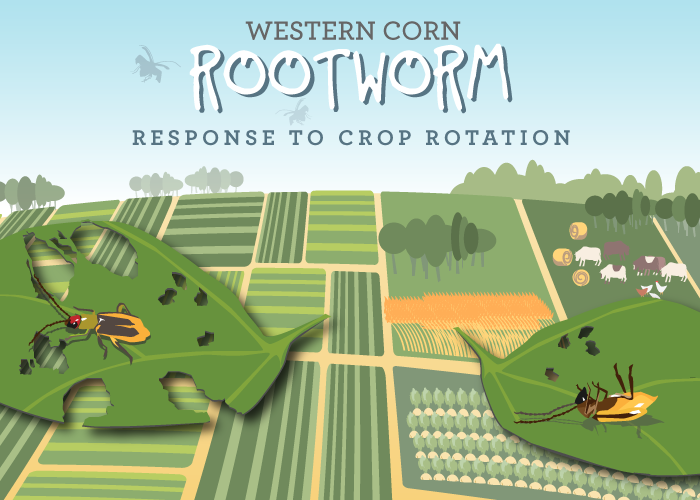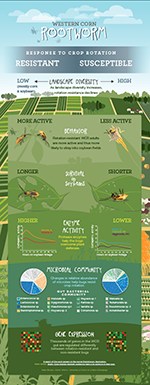Crop-rotation resistant rootworms have a lot going on in their guts

After decades of effort, scientists are finally figuring out how insects develop resistance to environmentally friendly farming practices - such as crop rotation - that are designed to kill them. The researchers say their insights will help develop more sustainable agricultural practices.
In their study, published in the journal Evolutionary Applications, the researchers report that the key to rotation-resistance, at least for the western corn rootworm, lies in its gut.
Previous research from this team, led by University of Illinois eco-physiologist Manfredo Seufferheld, found that heightened activity of protein-degrading enzymes and changes in the microbial community of the gut allowed rotation-resistant rootworm beetles to tolerate a diet of soybean leaves longer than other rootworm beetles. This gave them an advantage wherever crop rotation was practiced: If a female rootworm beetle lingered long enough in a soybean field to deposit her eggs there, and that field was planted with corn the following spring, her larvae would emerge, feed on corn roots and grow up to repeat the cycle. (Any larvae that emerge in soybean fields will die.)
The new study looks at gene expression in the insect's gut, and also finds significant differences between rotation-resistant and susceptible (also called "wild type") rootworm beetles. These differences in gene expression may help researchers develop molecular markers to identify rotation-resistant rootworms and improve rootworm-management strategies.
"We found many genes that are differentially expressed between wild-type and rotation-resistant rootworms - over 3,000 genes," Seufferheld said.

Some of these genes code for proteins involved in immune regulation and antimicrobial functions, he said. This could help explain the differences seen in microbial populations in the digestive systems of rotation-resistant and wild-type rootworms, he said. The same types of microbes are present in each, but in different proportions.
In an earlier study, Seufferheld and his colleagues found that rotation-resistant rootworms had higher activity of a protein known as cathepsin L. This enzyme helps the beetles digest soybean leaves and its increased activity gives rotation-resistant bugs an edge over their wild-type peers. When the researchers treated the bugs with antibiotics, however, the level of cathepsin L activity in the rotation-resistant rootworms dropped to that of the wild-type bugs. This caused the rotation-resistant beetles to die just as quickly as their wild-type peers on a diet of soybean leaves.
"The microbial community is somehow helping the rootworms boost the cathepsin levels," Seufferheld said. "We don't know exactly how.
"We also found differentially regulated genes involved in detoxification and genes involved in transport of metabolic products, lipids, sterols and drugs in and out of the cell," Seufferheld said. Some of these genes are associated with insect resistance to other toxins, he said.
The new study deepens scientists' understanding of the complex interplay of forces that give rise to rotation resistance, he said.
"The evolution of resistance in insects is complex: Human activity, the evolutionary history of the insects, the host and non-host plants, the microbial community and the genes all play a role," Seufferheld said.
All of these factors exist within an environmental context, he said. In areas dominated by corn and soybeans, rotation-resistance is more prevalent, while more diverse agricultural landscapes that also include corn and soybeans report no problem with rotation resistance.
"When we disturb the ecology with our agricultural landscape, there are going to be consequences - even with the most ecologically benign approaches, such as crop rotation," Seufferheld said. "Understanding the interplay of ecology and evolution will allow us to design more sustainable agricultural practices while minimizing undesirable consequences."
More information: Evolutionary Applications, onlinelibrary.wiley.com/doi/10 … 1/eva.12278/abstract
Provided by University of Illinois at Urbana-Champaign
















